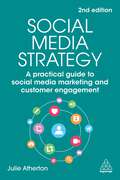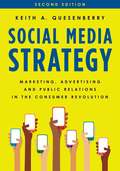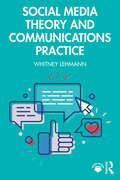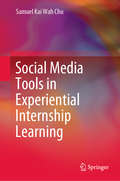- Table View
- List View
Social Media Strategy: A Practical Guide to Social Media Marketing and Customer Engagement
by Julie AthertonSocial Media Strategy provides a simple, structured way to create integrated customer engagement and social media campaigns that work. Organizations often talk of digital planning but struggle to know which channels to invest in, how to integrate them with content marketing activity, or fail to develop measurable outputs that align with business objectives. This book provides a clear road map for efficient planning, deliverance and financial accountability of social media's contribution to the business.Social Media Strategy delivers practical guidance such as identifying and targeting audience segments, methods of two-way community engagement, reputation management, being present on the right channels, and driving action through influencers. It also identifies the relevant tools and platforms to audit, track and measure business impact and customer engagement. With example templates, interviews and global case studies including National Geographic, TUI, Dreams Beds and Tiny Giant, this professional guide delivers a long-term solution for maximizing social media led business development.
Social Media Strategy: A Practical Guide to Social Media Marketing and Customer Engagement
by Julie AthertonSocial media marketing is no longer optional. This book unpacks the winning formula for effective social media marketing complete with comprehensive updates and latest developments.Integrated marketing and PR strategies are a requirement for all businesses but with the explosion of social media and content marketing many organizations still struggle to know which channels to invest in and how to maximize their impact. Social Media Strategy gives clear guidance with a simple structured approach to executing campaigns that work. It provides a blueprint for planning, delivering and measuring social media's contribution to your business through:- Identifying and targeting audience segments - Maximizing social search - Enhanced reputation management - Managing a diversified influencer portfolio - Selecting the right channels for organic and paid social - Creating a process and structure to improve efficiencies- Using appropriate technology including AIWith explanations of best-practice tools and practical downloadable templates, this new edition includes new and updated interviews and case studies from industry leaders, influencers and brands including TUI, Greggs, Lego, Ryan Air, National Geographic and others. Social Media Strategy delivers a long-term solution for maximizing social media-led business development.
Social Media Strategy: A Practical Guide to Social Media Marketing and Customer Engagement
by Julie AthertonSocial media marketing is no longer optional. This book unpacks the winning formula for effective social media marketing complete with comprehensive updates and latest developments.Integrated marketing and PR strategies are a requirement for all businesses but with the explosion of social media and content marketing many organizations still struggle to know which channels to invest in and how to maximize their impact. Social Media Strategy gives clear guidance with a simple structured approach to executing campaigns that work. It provides a blueprint for planning, delivering and measuring social media's contribution to your business through:- Identifying and targeting audience segments - Maximizing social search - Enhanced reputation management - Managing a diversified influencer portfolio - Selecting the right channels for organic and paid social - Creating a process and structure to improve efficiencies- Using appropriate technology including AIWith explanations of best-practice tools and practical downloadable templates, this new edition includes new and updated interviews and case studies from industry leaders, influencers and brands including TUI, Greggs, Lego, Ryan Air, National Geographic and others. Social Media Strategy delivers a long-term solution for maximizing social media-led business development.
Social Media Strategy: Marketing, Advertising, And Public Relations In The Consumer Revolution (PDF)
by Keith A. QuesenberrySocial Media Strategy: Marketing, Advertising and Public Relations in the Consumer Revolution, Second Edition is a blueprint for the practice of marketing communications, advertising and public relations in a digital world where the consumer has taken control. The consumer revolution is not about giving up or giving in; it is about adjusting methods to affect change, support traditional efforts, and leverage consumer influence for the good of the brand whether it's a small business, large corporation or non-profit organization. Its real world examples and statistics make it a highly accessible text for students. This new and updated edition presents a fuller, integrated approach to the traditional disciplines of marketing, advertising, and public relations. Adopters of the first edition will find the original structure and approach in tact with additions that take a more integrated look at social media strategy. It features a new chapter on law, ethics and etiquette, and updates on key topics such as social media careers, personal branding, storytelling, paid social media, messaging apps, live video, influencer marketing, B2B social selling, and all major social media platforms. Enhanced pedagogical features include: *social media calendars, metrics, and budgets; *chapter checklists to keep statistics updated; *expanded chapter previews; *new case studies and a 200-word glossary; and *updated online tools and resources.
Social Media Strategy in Policing: From Cultural Intelligence to Community Policing (Security Informatics and Law Enforcement)
by Babak Akhgar Petra Saskia Bayerl George LeventakisThis book addresses conceptual and practical issues pertinent to the creation and realization of social media strategies within law enforcement agencies. The book provides readers with practical methods, frameworks, and structures for understanding social media discourses within the operational remit of police forces and first responders in communities and areas of concern. This title - bridging the gap in social media and policing literature - explores and explains the role social media can play as a communication, investigation, and direct engagement tool. It is authored by a rich mix of global contributors from across the landscape of academia, policing and experts in government policy and private industry. Presents an applied look into social media strategies within law enforcement;Explores the latest developments in social media as it relates to community policing and cultural intelligence; Includes contributions and case studies from global leaders in academia, industry, and government.
Social Media Theory and Communications Practice
by Whitney LehmannFusing the academic with the applied, this book provides a comprehensive introduction to social media for future communications professionals.While most social media texts approach the subject through either a theoretical, scholarly lens or a professional, practical lens, this text offers a much-needed linkage of theory to the practical tactics employed by social media communicators. Concise and conversational chapters break down the basics of both social media theory and practice and are complemented by sidebars written by scholars and industry professionals, chapter summaries and end-of-chapter exercises.This book is ideal for introductory social media courses in communication, public relations and mass communication departments, as well as courses in digital media and public relations.Online resources include social media writing templates, sample posts and content calendar templates. Please visit www.routledge.com/9781032185873.
Social Media Theory and Communications Practice
by Whitney LehmannFusing the academic with the applied, this book provides a comprehensive introduction to social media for future communications professionals.While most social media texts approach the subject through either a theoretical, scholarly lens or a professional, practical lens, this text offers a much-needed linkage of theory to the practical tactics employed by social media communicators. Concise and conversational chapters break down the basics of both social media theory and practice and are complemented by sidebars written by scholars and industry professionals, chapter summaries and end-of-chapter exercises.This book is ideal for introductory social media courses in communication, public relations and mass communication departments, as well as courses in digital media and public relations.Online resources include social media writing templates, sample posts and content calendar templates. Please visit www.routledge.com/9781032185873.
Social Media Tools and Platforms in Learning Environments
by Bebo White, Irwin King and Philip TsangOnline social media have transformed the face of human interaction in the 21st century. Wikis, blogs, online groups and forums, podcasts, virtual worlds, and social tagging are but a few of the applications enabling innovative behaviors that support acquisition, access, manipulation, retrieval, and visualization of information. It is, therefore, no surprise that educational practitioners and theorists have begun to explore how social media can be harnessed to describe and implement new paradigms for communication, learning, and education.The editors’ goal in publishing this book was to identify original research on the application of online social media and related technologies in education as well as emerging applications in Web technologies that could provide and shape future educational platforms. The selected contributions deal with questions such as how social media can truly enrich and enhance learning and teaching experiences in ways not otherwise possible; how learning can be integrated in a distributed and ubiquitous social computing environment; or what theories, paradigms, and models are applicable for the support of social computing in education. Researchers in education or educational software will find interesting and sometimes provocative chapters on paradigms and methodologies, virtual and mobile learning spaces, and assessment and social factors. Practitioners in these fields will benefit from an additional section devoted to case studies and first experience reports.
Social Media Tools in Experiential Internship Learning
by Samuel Kai ChuThis book describes how a support structure can be built to enhance peer-to-peer (and also students-to-lecturers) communication and support. It informs lecturers on how they can decide if they should adopt one or more social media tools to facilitate students’ learning, communication, and support for an internship program. This book introduces a participatory design approach that can help develop a pedagogy that will make good use of social media tools on internship learning. It presents a framework for experiential internship learning, integrating helpful educational practices such as participatory design approach and the use of social media.
Social Media Use in Crisis and Risk Communication: Emergencies, Concerns and Awareness
by Editors Harald Hornmoen Klas BackholmCrises pose an immediate risk to life, health, and the environment and require urgent action. The public’s use of social media has important implications for contingency policies and practices. Social media have the potential for risk reduction and preventive interaction with the public. This book is about how different communicators - whether crisis managers, first responders, journalists, or private citizens and disaster victims - have used social media to communicate about risks and crises. It is also about how these very different actors can play a crucial role in mitigating or preventing crises. How can they use social media to strengthen their own and the public’s awareness and understanding of crises when they unfold? How can they use social media to promote resilience during crises and the ability to deal with the after-effects? Chapters address such questions by presenting new research-based knowledge on social media use during different crises: the terrorist attacks in Norway on 22 July 2011; the central European floods in Austria in 2013; and the West African Ebola-outbreak in 2014. The collection also presents research on the development of a tool for gathering social media information, based on a user-centered design. Social Media use in Crisis and Risk Communication presents cutting-edge research on the use of social media in crisis communication and reporting.
Social Media Use in Crisis and Risk Communication: Emergencies, Concerns and Awareness (PDF)
by Editors Harald Hornmoen Klas BackholmCrises pose an immediate risk to life, health, and the environment and require urgent action. The public’s use of social media has important implications for contingency policies and practices. Social media have the potential for risk reduction and preventive interaction with the public. This book is about how different communicators - whether crisis managers, first responders, journalists, or private citizens and disaster victims - have used social media to communicate about risks and crises. It is also about how these very different actors can play a crucial role in mitigating or preventing crises. How can they use social media to strengthen their own and the public’s awareness and understanding of crises when they unfold? How can they use social media to promote resilience during crises and the ability to deal with the after-effects? Chapters address such questions by presenting new research-based knowledge on social media use during different crises: the terrorist attacks in Norway on 22 July 2011; the central European floods in Austria in 2013; and the West African Ebola-outbreak in 2014. The collection also presents research on the development of a tool for gathering social media information, based on a user-centered design. Social Media use in Crisis and Risk Communication presents cutting-edge research on the use of social media in crisis communication and reporting.
Social Media Use in University Studies (Numanities - Arts and Humanities in Progress #13)
by Giedre Valunaite Oleskeviciene Jolita SliogerieneThis book highlights the phenomenon of social media use in university studies based on its participants’ lived experience. It will appeal both to academics and practitioners interested in the human factors in the study environments saturated with technologies of social media. This book reveals multiple, sometimes contradictory dimensions of the phenomenon. The contradictions acquire a binary Janus-faced characteristic of uncertainty and paradox. Social media use in university studies also causes changes in experiencing time, space and relations. Teacher research participants sometimes perceive their time as stress or an additional load, which shows that social media use in university studies demands a new approach to teacher workload and its regulation. There is also the necessity of the sensitive democratic teacher—student pedagogical relationship. This book proves that the pedagogical relationship and human creativity essentially belong to the human living world and are still at the heart of the technological “cyborgian” existence.
Social Media Warfare: Equal Weapons for All
by Michael ErbschloeSocial media applications can be weaponized with very little skill. Social media warfare has become a burden that nation states, government agencies, and corporations need to face. To address the social media warfare threat in a reasonable manner that reduces uncertainty requires dedication and attention over a very long-term. To stay secure, they need to develop the capability to defend against social media warfare attacks. Addressing unconventional warfare strategies and tactics takes time and experience, plus planning and dedication. This book will help managers develop a sound understanding of how social media warfare can impact their nation or their organization.
Social Media Warfare: Equal Weapons for All
by Michael ErbschloeSocial media applications can be weaponized with very little skill. Social media warfare has become a burden that nation states, government agencies, and corporations need to face. To address the social media warfare threat in a reasonable manner that reduces uncertainty requires dedication and attention over a very long-term. To stay secure, they need to develop the capability to defend against social media warfare attacks. Addressing unconventional warfare strategies and tactics takes time and experience, plus planning and dedication. This book will help managers develop a sound understanding of how social media warfare can impact their nation or their organization.
SOCIAL MEDIA IN THE MARKETING CONTEXT: A State of the Art Analysis and Future Directions (pdf)
by Geoff Walton Woody Evans Cherniece J. Plume Yogesh K. Dwivedi Emma L. Slade9780081017548
Social Mentality and Public Opinion in China (China Perspectives)
by Fanbin ZengThis book explores the relationship between social mentality, public opinion, media, and other factors through mixed methods in China, especially since the 21st century.The book deploys qualitative and quantitative research and adopts a multi-disciplinary perspective and diversified research methods. The studies are built on and contribute to the burgeoning literature seeking to anatomize the relationship between social mentality, media, and public opinion from the point of view of sociology and communication. It also aims to explore how media can be used to appease public opinion. As the first systematic study of the interconnection between social mentality and public opinion, this book provides empirical support and a theoretical framework for both areas. It will thus be a great read for students and scholars of communication, sociology, and social psychology, especially for those with a focus on China and new media.
Social Mentality and Public Opinion in China (China Perspectives)
by Fanbin ZengThis book explores the relationship between social mentality, public opinion, media, and other factors through mixed methods in China, especially since the 21st century.The book deploys qualitative and quantitative research and adopts a multi-disciplinary perspective and diversified research methods. The studies are built on and contribute to the burgeoning literature seeking to anatomize the relationship between social mentality, media, and public opinion from the point of view of sociology and communication. It also aims to explore how media can be used to appease public opinion. As the first systematic study of the interconnection between social mentality and public opinion, this book provides empirical support and a theoretical framework for both areas. It will thus be a great read for students and scholars of communication, sociology, and social psychology, especially for those with a focus on China and new media.
Social, Mobile, and Emerging Media Around the World: Communication Case Studies (PDF)
by Edited by Alexander V. LaskinSocial, Mobile, and Emerging Media around the World: Communication Case Studies is an edited collection of cutting edge research on the practical applications of diverse types of emerging media technologies in a variety of industries and in many different regions of the world. In recent years, emergent social media have initiated a revolution comparable in impact to the industrial revolution or the invention of the Internet. Today, social media's usage statistics are mind-boggling: almost two billion people are Facebook users, over one billion people communicate via What'sApp, over forty billion pictures are posted on Instagram, and over one million snaps are sent on Snapchat daily. This edited collection analyzes the influence of emerging media technologies on governments, global organizations, non-profits, corporations, museums, restaurants, first responders, sports, medicine, television, and free speech. It studies such new media phenomena as brandjacking, crowd-funding, crowd-mapping, augmented reality, mHealth, and transmedia, focusing specifically on new media platforms like Facebook and Facebook Live, Twitter, Sina Weibo, Yelp, and other mobile apps.
Social Monitoring for Public Health (Synthesis Lectures on Information Concepts, Retrieval, and Services)
by Michael J. Paul Mark DredzePublic health thrives on high-quality evidence, yet acquiring meaningful data on a population remains a central challenge of public health research and practice. Social monitoring, the analysis of social media and other user-generated web data, has brought advances in the way we leverage population data to understand health. Social media offers advantages over traditional data sources, including real-time data availability, ease of access, and reduced cost. Social media allows us to ask, and answer, questions we never thought possible. This book presents an overview of the progress on uses of social monitoring to study public health over the past decade. We explain available data sources, common methods, and survey research on social monitoring in a wide range of public health areas. Our examples come from topics such as disease surveillance, behavioral medicine, and mental health, among others. We explore the limitations and concerns of these methods. Our survey of this exciting new field of data-driven research lays out future research directions.
Social Movements and Their Technologies: Wiring Social Change
by Stefania MilanNow in paperback for the first time, Social Movements and their Technologies explores the interplay between social movements and their 'liberated technologies'. It analyzes the rise of low-power radio stations and radical internet projects ('emancipatory communication practices') as a political subject, focusing on the sociological and cultural processes at play. It provides an overview of the relationship between social movements and technology, and investigates what is behind the communication infrastructure that made possible the main protest events of the past fifteen years. In doing so, Stefania Milan illustrates how contemporary social movements organize in order to create autonomous alternatives to communication systems and networks, and how they contribute to change the way people communicate in daily life, as well as try to change communication policy from the grassroots. She situates these efforts in a historical context in order to show the origins of contemporary communication activism, and its linkages to media reform campaigns and policy advocacy.
Social Multimedia Signals: A Signal Processing Approach to Social Network Phenomena
by Suman Deb Roy Wenjun ZengThis book provides a comprehensive coverage of the state-of-the-art in understanding media popularity and trends in online social networks through social multimedia signals. With insights from the study of popularity and sharing patterns of online media, trend spread in social media, social network analysis for multimedia and visualizing diffusion of media in online social networks. In particular, the book will address the following important issues: Understanding social network phenomena from a signal processing point of view; The existence and popularity of multimedia as shared and social media, how content or origin of sharing activity can affect its spread and popularity; The network-signal duality principle, i.e., how the signal tells us key properties of information diffusion in networks; The social signal penetration hypothesis, i.e., how the popularity of media in one domain can affect the popularity of media in another. The book will help researchers, developers and business (advertising/marketing) individuals to comprehend the potential in exploring social multimedia signals collected from social network data quantitatively from a signal processing perspective.
Social Navigation of Information Space (Computer Supported Cooperative Work)
by Alan J. Munro Kristina Höök David BenyonThis volume examines how people deal with information in a computerized environment, looking at what happens when people actively explore information space looking for objects without specific goals in mind. The topics are particularly relevant to the industrial application of computer supported cooperative work (CSCW) techniques, especially with regard to teleworking and virtual organizations. This volume will be useful for researchers interested in human computer interaction, virtual communities, and information visualization.
Social Network Analysis: Interdisciplinary Approaches and Case Studies
by Margarete Boos Xiaoming Fu Jar-Der LuoThe book addresses the issue of interdisciplinary understanding of collaboration on the topic of social network studies. Researchers and practitioners from various disciplines including sociology, computer science, socio-psychology, public health, complex systems, and management science have worked largely independently, each with quite different principles, terminologies, theories. and methodologies. The book aims to fill the gap among these disciplines with a number of the latest interdisciplinary collaboration studies.
Social Network Analysis and Law Enforcement: Applications for Intelligence Analysis (Crime Prevention and Security Management)
by Morgan BurcherThis book examines the use of social network analysis (SNA) in operational environments from the perspective of those who actually apply it. A rapidly growing body of literature suggests that SNA can reveal significant insights into the overall structure of criminal networks as well as the position of critical actors within such groups. This book draws on the existing SNA and intelligence literature, as well as qualitative interviews with crime intelligence analysts from two Australian state law enforcement agencies to understand its use by law enforcement agencies and the extent to which it can be used in practice. It includes a discussion of the challenges that analysts face when attempting to apply various network analysis techniques to criminal networks. Overall, it advances SNA as an investigative tool, and provides a significant contribution to the field that will be of interest to both researchers and practitioners interested in social network analysis, intelligence analysis and law enforcement.
Social Network Analysis Applied to Team Sports Analysis (SpringerBriefs in Applied Sciences and Technology)
by Filipe Manuel Clemente Fernando Manuel Martins Rui Sousa MendesExplaining how graph theory and social network analysis can be applied to team sports analysis, This book presents useful approaches, models and methods that can be used to characterise the overall properties of team networks and identify the prominence of each team player. Exploring the different possible network metrics that can be utilised in sports analysis, their possible applications and variances from situation to situation, the respective chapters present an array of illustrative case studies. Identifying the general concepts of social network analysis and network centrality metrics, readers are shown how to generate a methodological protocol for data collection. As such, the book provides a valuable resource for students of the sport sciences, sports engineering, applied computation and the social sciences.



















